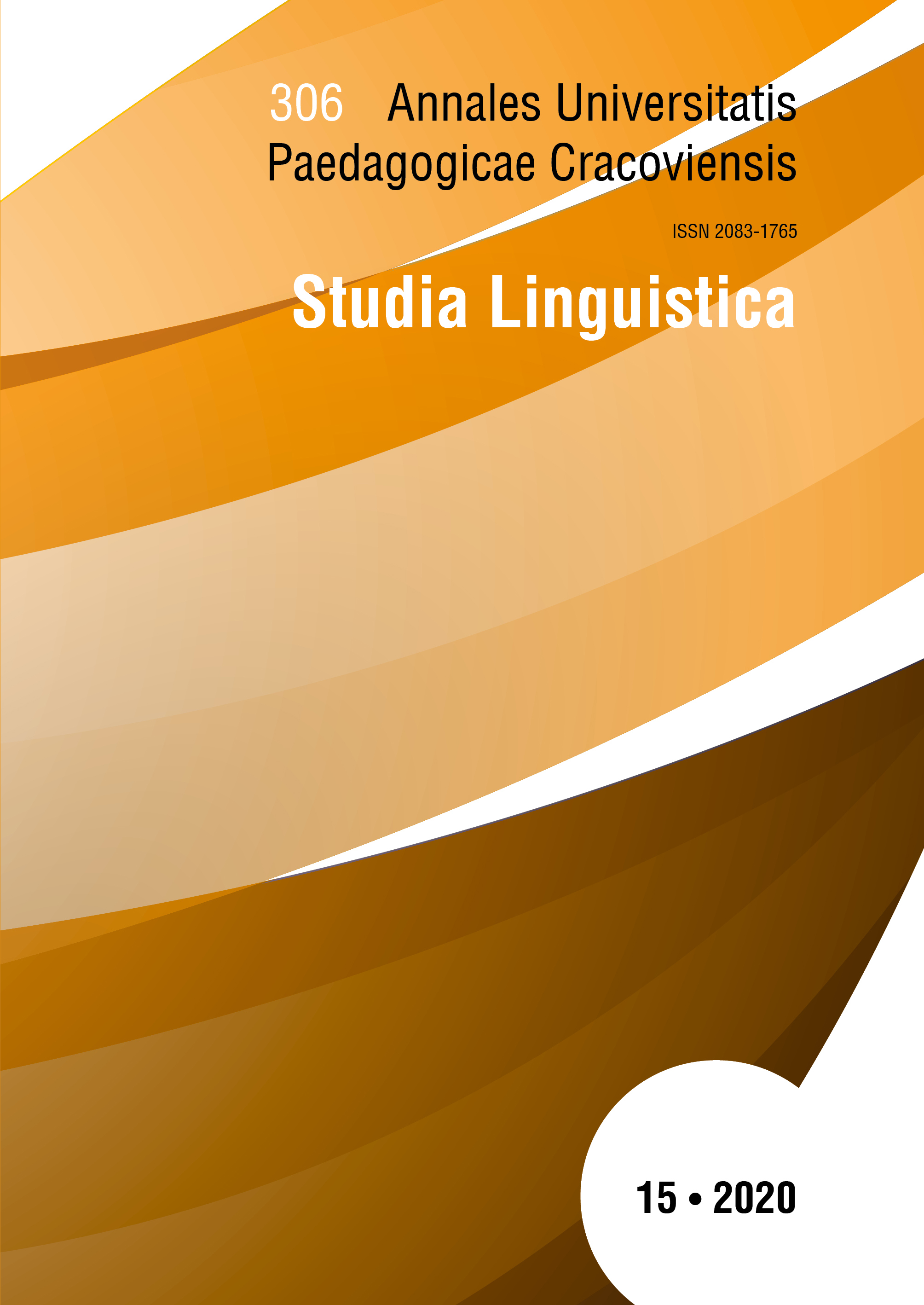Functionality of language games in the press of the second publishing circulation of the late 1970s
Main Article Content
Abstract
The article presents the functionality of language games in texts representing the unofficial press discourse of the late ‘70s (press). The non-censorship journalism of the second publishing circulation, published outside the censorship, created a space for independent debate and presented the point of view of the pre-solidarity opposition; therefore, it developed communication practices that were alternative to Newspapers as the basic model of Polish in the press at the time (and in public communication). Language games (lexical, syntactic, text, and intertextual) strengthened the persuasive influence of the second cycle press texts, in which new topics were introduced and a new community of values was defined. In a broader sense, the presence of language games in independent journalism can be treated as a signal of reproduction of public communication after a period of dominant newspeak - excluding and actually anti-communication.
Downloads
Article Details
Author, submitting a text to the editorial board of the journal “Annales Universitatis Paedagogicae Cracoviensis. Studia Linguistica", certifies that the content of the article has not been published so far and that the work does not violate in any way the copyright or related rights of other person, as well as other rights of third parties, and that no one's rights to the work (or any part thereof) have been missed. After signing the contract, the property rights to the published materials are transferred to the Scientific Publisher of the University of the National Education Commission, Krakow.
“Annales Universitatis Paedagogicae Cracoviensis. Studia Linguistica” is an open access journal, and all its content is made available free of charge to users and institutions under the Creative Commons CC-BY-NC-ND 4.0 license (attribution, non-commercial use, no derivative works). Under this license, the authors agree that their work may be lawfully reused for any purpose, except for commercial purposes, without the prior consent of the author or publisher. Everyone can read, download, copy, print, distribute and process these works, provided that the author's marking and the original publication place are correct. Published texts may not be used to create derivative works (e.g. to translate and publish in another language without the consent of the publisher). This is in line with the BOAI (Budapest Open Access Initiative) definition. "Studia Linguistica" does not charge for submitting or processing articles.
References
Balcerzan E., 2000, W stronę genologii multimedialnej [w:] Genologia dzisiaj, red. W. Bolecki, I. Opacki, Warszawa, s. 86-101.
Google Scholar
Bartmiński J., 2010, „Język IV RP”, czyli o karierze przecieku. Problem wiarygodności dyskursu publicznego, [w:] Język IV RP, red. R. Przybylska, P. Nowak, P. Czerwiński , Lublin, s. 7-31.
Google Scholar
Bralczyk J., 2001, O języku polskiej propagandy politycznej lat siedemdziesiątych, Warszawa.
Google Scholar
Encyklopedia Solidarności, http://www.encysol.pl/wiki/Strona_g%C5%82%C3%B3wna (dostęp 06. 03. 2020).
Google Scholar
Friszke A., 2012, Czasopisma drugiego obiegu, [w:] Czasopisma społeczno-kulturalne w okresie PRL, red. U. Jakubowska, Warszawa.
Google Scholar
Głowiński M., 1991, Nowomowa po polsku, Warszawa.
Google Scholar
Głowiński M., 2001, Nowomowa, [w:] Współczesny język polski, red. J. Bartmiński, Lublin, s. 173-182.
Google Scholar
Głowiński M., 2013, Nowomowa i ciągi dalsze. Szkice dawne i nowe, Kraków 2013.
Google Scholar
Kamińska-Szmaj I., 2016, U źródeł politycznego dyskursu dominującego w czasach PRL, [w:] Dyskurs i jego odmiany, red. B. Witosz, K. Sujkowska-Sobisz, E. Ficek, Katowice, s. 121-131.
Google Scholar
Kępa-Figura D., 2009, Gry językowe we współczesnej komunikacji medialnej – semantyczna i pragmatyczna analiza języka mediów, „Prace Językoznawcze” XI, s. 95-113.
Google Scholar
Kępa-Figura D., 2012, Performatywność w komunikacji medialnej [w:] Performatywne wymiary kultury, red. K. Skowronek, K. Leszczyńska, Kraków, s. 243-255.
Google Scholar
Kudra A., Jeziorska D., 2010, Językowe znaki świadomości kolektywnej i ich chiralna zasada konceptualizacyjna (o neonowomowie IV RP, [w:] Język IV RP, red. R. Przybylska, P. Nowak, P. Czerwiński, Lublin, s. 181-189.
Google Scholar
Łuc I., 2010, Współczesne gry komunikacyjnojęzykowe, Katowice.
Google Scholar
Ożóg K., 2011, Polszczyzna przełomu XX i XXI wieku.Wybrane zagadnienia, Rzeszów.
Google Scholar
Ożóg K., 2014, Rytualizacja w języku władzy komunistycznej PRL [w:] Oblicza komunikacji. Język polityki – historia i współczesność, Wrocław, red. I. Kamińska-Szmaj, T. Piekot, M. Poprawa, Wrocław, s. 37‒50.
Google Scholar
Skowronek K., Rutkowski, 2004, Media i nazwy, Kraków.
Google Scholar
Skowronek B., 2016, Współczesny dyskurs polityczny a zjawisko nowomowy, „Annales Universitatis Paedagogicae Cracoviensis. Studia Linguistica” XI, s. 110-118.
Google Scholar
Suska D., 2017, Dyskurs wokół śmierci Stanisława Pyjasa (językowe strategie zarządzania kryzysem w prasie krakowskiej), „Acta Universitatis Lodziensis. Folia Litteraria Polonica” 3(41), s. 115-132.
Google Scholar
Suska D., 2019, Konceptualizowanie Innego w prasie okresu przedsolidarnościowego (1978-1980). Od stereotypu wroga do oponenta politycznego, „Studia Filologiczne Uniwersytetu Jana Kochanowskiego w Kielcach”, t. 32, s. 271-287.
Google Scholar
Suska D., (w druku), The style of independent periodicals in 1979–1980 in the face of the dominant ideologicaldiscourse, „Acta Universitatis Lodziensis. Folia Litteraria Polonica”.
Google Scholar
Szczepankowska I., 2016, Konstelacja dyskursów związanych tematycznie i funkcjonalnie ze sferą prawa – próba typologii, [w:] Dyskurs i jego odmiany, red. B. Witosz, K. Sujkowska-Sobisz, E. Ficek, Katowice, s.31-40.
Google Scholar
Wojsław J., 2017, Figura wroga w ideologii i propagandzie XX-wiecznych totalitaryzmów – przyczynek do dyskusji, „Media. Biznes. Kultura”, nr 1 (2), s. 47-63.
Google Scholar
